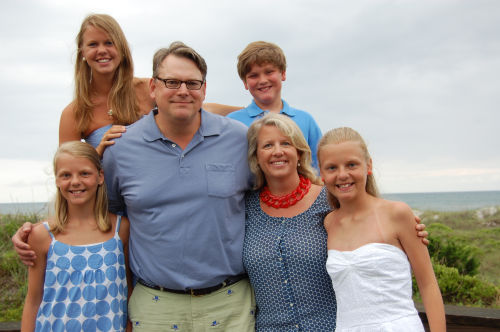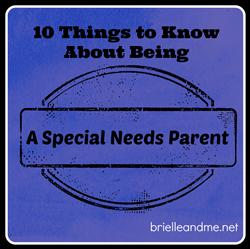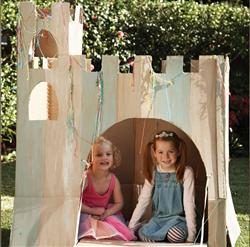The Divorce Fairytale: Part 4 “Blending Families”
By Guest Blogger Clare Jordan
Today’s post completes a 4-part series that Clare has generously shared with TMoM readers. If this is the first day you are tuning into the series, be sure to go back and read the first three parts: Part 1: “Divorce” , Part 2:”Dating” , and Part 3: “Remarrying”. While this is the end of the series, Clare says there may be an occasional update as the “happily ever after” continues. Many thanks to today’s blogger for another helpful and entertaining post! ~ Katie
That “blended family” label sounds to me like we’ve been thrown into a giant blender and smushed together to create a family smoothie. Much like the “melting pot” analogy, it is not as pretty or simple as it sounds.
For those who have read the previous three entries in this blog series, I have to say that this fourth and final installment is the most challenging to write. It is not hard for me to share my story and I do it willingly, but the sequential order means that blending our families remains an ongoing topic for me. And as such, it means I am still learning about this one myself.
Like any family blended families are continually learning who we are and how we can do what we do better (or worse).
And like any family, we do not exist without other influences – for better or worse as well – except that in blended families, we have more of them! Just think about it: not only are we our own family unit; but we are also part of at least two other family units, aside from our own, by nature of the prior divorced families from which we came. And those families each have their own set of in-laws, other relatives, etc.
That is a lot of outside influences. When you think of it this way, it’s a miracle we are able to survive at all!
For background, we are a family of six: Fred and me, plus my three girls (ages 20 and twin almost 16-year-olds), and his son, Jack (14). We met in 2010, so our four children have really grown up with us. When people ask, I always say, “We have four children.” I work hard not to designate “his” and “mine,” and I rarely ever use “step” terminology; we are a family, and together, we have four children.
I often say that no good thing happens without some amount of risk, and the statistics on blended families’ success rates certainly bear some inherent risks – if you want to look at that way.
I am no expert, but it’s easy to find the data:
- In 2006, the U.S. Census Bureau found that 60% of second marriages and 73% of third marriages end in divorce.
- “Women who already have children at the time of remarriage are more likely to have their second marriage end in divorce than women who do not have any children at the time of remarriage. After 10 years of remarriage, the probability of that marriage ending is 32% for women with no children at remarriage and 40% for women with children,” according to the National Center for Health Statistics (2002).
A family law attorney writing for the Huffington Post recently attempted to address the reasons for these high rates of failure, stating “Often the new wedded couple will start off with an instant blended family and a host of attendant issues — from needing a larger home, confronting differing parenting styles, clashes that arise between the children which cause parents to take sides, establishing family rules and the possibility of having to interact with your partner’s ex.”
So given all of this, no wonder we face ongoing challenges! Having survived that first 3-year hurdle, our marriage and blended family is journeying into our fourth year now, and I can share just a few areas of advice that may help someone else in our shoes:
- Set your expectations. We all parent differently, so it is very important to discuss parenting styles, discipline strategies, and as our therapist has taught us – what is essential for you. Defining together those elements that are essential for your family helps prevent and resolve those inevitable disagreements over less important issues, and establish our shared values. Remember not to expect too much of each other too – there is no such thing as Mr. & Mrs. Perfect, and our children have all have their faults as well.
- Clearly determine roles. We try to parent our children together, and we try to be fair, if not always equal. It is hard for us as parents to recognize our natural biases toward our children and to acknowledge that we can’t help but fall into certain tendencies that can be seen as favoritism among new siblings. Former spouses’ influences can strain this already difficult position as they can manipulate children’s impressions outside of our home, something over which we have no control, other than to overcome it in our own home by firmly maintaining our position as parents together.
- Communicate! It is a no-brainer that good communication is key for successful families, but just multiply that for blended families who just have to work harder to make everything work. You have to be willing and able to TALK to each other and to LISTEN to one another – duh!
- Prioritize your marriage. I was given this great advice many years ago, and it bears even more relevance for blended families – your marriage has to come before your children. Some people will argue me on that, but I am firm in my belief that if we are not good as a couple, we are not good for our children (or anyone else). The marriage has to come first in family priorities! Putting your children first may sound nice, but it is a mistake.
- Remember why you got married. If I can’t look at Fred at the end of the day – even at times when I may be upset with him – and remember why I love him and how happy I was to marry him, then we have trouble. Our children know that we love each other, and that carries us a long way.







